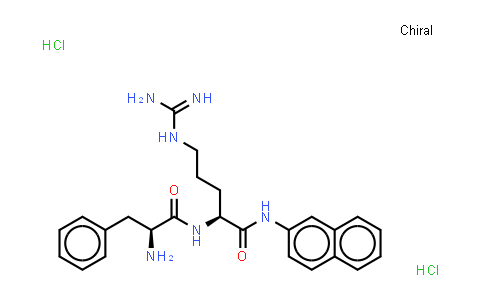
PAβN (dihydrochloride) NLT 98%
Product Number : MC501334
CAS Number : 100929-99-5
Molecular Formula : C25H32Cl2N6O2 | Molecular Weight : 519.47
Synonyms : MC-207,110 dihydrochloride;Phe-Arg-β-naphthylamide dihydrochloride
Quote Request| Purity | NLT 98% |
|---|---|
| Storage | at 20ºC 2 years |
| MolCore specializes in manufacturing high-purity CAS No.100929-99-5, PAβN (dihydrochloride) with the molecular formula C25H32Cl2N6O2 and molecular weight 519.47 delivering critical API intermediates for global pharmaceutical and research industries, certified under ISO quality systems. | |
* The above information is for reference only.
| Chemical Name | PAβN (dihydrochloride) |
|---|---|
| CAS Number | 100929-99-5 |
| MDL Number | MFCD00058046 |
| Molecular Formula | C25H32Cl2N6O2 |
| Molecular Weight | 519.47 |
| Synonyms | MC-207,110 dihydrochloride;Phe-Arg-β-naphthylamide dihydrochloride |
PAβN dihydrochloride (MC-207110 dihydrochloride) is an efflux pump inhibitor. In Vitro: PAβN increases the susceptibilities of the three pump-overexpressing mutants of P. aeruginosa to levofloxacin 64-fold. PAβN also potentiates the activity of levofloxacin against strain PAM2391 containing plasmid pAGH97 with the mexXY genes and against wild-type strain PAM1020. PAβN has an effect on susceptibilities to other antibiotics that are substrates of efflux pumps. PAβN increases levels of accumulation of efflux pump substrates inside the cell. It enhances the activity of levofloxacin against clinical isolates of P. aeruginosa[1]. PAβN reduces the MICs in nine ciprofloxacin-resistant isolates, and in four of these, PAβN increases the susceptibility by twofold. Moreover, PAβN restores ciprofloxacin susceptibility in five of the ciprofloxacin-resistant isolates. In addition, clear effects of NMP on the ciprofloxacin MICs are seen for 20 of these ciprofloxacin-resistant isolates[2]. PAβN permeabilizes bacterial membranes in a concentration-dependent manner at levels below those typically used in combination studies, and this additional mode of action should be considered when using PAβN as a control for efflux studies[3].
© Copyright 2015-2025 Hangzhou MolCore BioPharmatech Co.,Ltd. All rights reserved.
